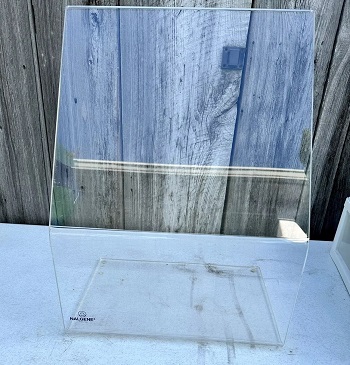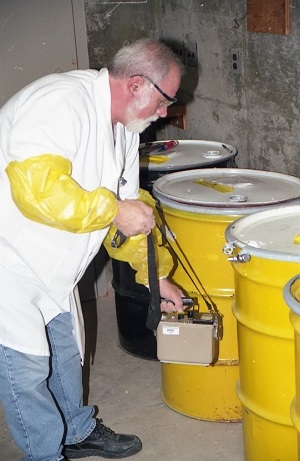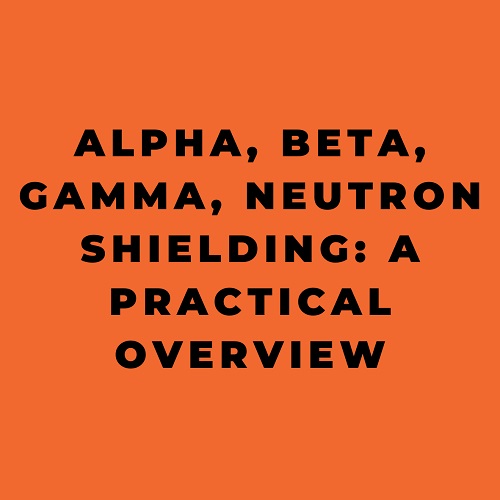More about radiation shielding!
Hey Dr Zoomie – about a year ago you wrote a piece about shielding, but it only went into gamma shielding; I was wondering if you could talk about how to shield other forms of radiation.
I remember that piece! And I can even add a little to it – I mostly discussed using lead to shield gamma and x-ray radiation, but they can also be shielded with concrete, soil, or even water; 4” of concrete, 6” of soil, or a foot of water will all provide as much gamma shielding as an inch of lead, and without the problems of lead toxicity. If you need a compact gamma shield then lead, tungsten, or depleted uranium are the way to go; if space is no issue, any of the others will do the trick just as effectively. The big thing with the photons – x-ray and gamma rays – is that they’re penetrating, and the amount of shielding needed depends on the energy of the photons. On top of that, gammas will scatter as they pass through a shield, emerging from the shield in random directions and exposing areas that would otherwise have been spared. That’s why there’s software out there specifically aimed at helping to design radiation shielding.
You really don’t need any shielding for alpha radiation, you only need to keep it on the outside of your body. So wear gloves if you’re handing an alpha source, cover any cuts or scrapes, to keep contamination out of your bloodstream, and wear respiratory protection if some might get into the air – you’ll be fine!
Beta radiation calls for more stopping power than alpha, but not nearly as much as x-ray and gamma radiation. It’s actually possible to completely shield beta radiation, unlike x-rays and gammas. Beta radiation can only pass through about ½” (1 cm) of tissue or water; put another way, a thick pork chop would make a great beta shield…well…except for the part where it will smell bad when it starts to rot. So maybe a pork chop beta shield might not be a good idea after all. Having said all that, there is one complication to avoid – what’s called bremsstrahlung.
Bremsstrahlung is x-ray radiation that’s given off when a charged particle changes direction abruptly due to passing close to an atom, and when those atoms are heavy (e.g. lead) there are more bremsstrahlung x-rays given off and they each have a higher energy. Putting a piece of lead foil in front of a beta source will completely stop all of the beta radiation, but it turns into a mini x-ray generator, turning a skin dose into a whole-body radiation exposure. This is why beta-emitting radionuclides tend to be transported in plastic and why research labs that use beta-emitters are filled with plastic shielding – to minimize bremsstrahlung.

Where things get tricky – even more so than with gammas and x-rays – is when we’re trying to shield a neutron-emitting source. Neutrons can pass through the several inches of lead in a shield designed to contain radiation from thousands of curies of Co-60 or Cs-137; on the other hand, those same neutrons will be stopped by anywhere from several inches to a foot or so of water, paraffin, or plastic. People would make a reasonably good neutrons shield, except for the whole ALARA thing (keeping radiation exposures as low as reasonably achievable). Well…that, plus dose limits, ethical considerations, potential future lawsuits, and generally just being a mean thing to do. Neutrons are particles with an atomic mass of about 1; they slow down by exchanging energy with atoms that they run into and bounce off of while passing through a shield, and they exchange energy most effectively when they bounce off atoms that are close to them in mass. Like hydrogen atoms! Hydrogenous materials – water, plastic, paraffin, fuel, lubricating oil…even pork chops…all contain enough hydrogen to effectively shield neutrons. The down side is that neutrons can cause stable atoms to become radioactive – any atoms other than hydrogen can, over time, cause induced radioactivity to increase.
Simple, low-activity neutron sources are usually shipped in packages designed to reduce neutron radiation to acceptable levels and they’re typically made of plastic (for low-activity sources) or a barrel of paraffin – one of my higher-activity neutron sources was shipped in a 55-gallon drum filled with paraffin; a lower-activity source was shipped to us in a box with 3”-thick plastic sides. But concrete contains water and a number of light atoms; it will also shield neutrons if it’s thick enough. You’ve likely noticed that shielding neutrons is complex – a bit more so than with photons. For anything other than the simplest situations (i.e. my low-activity neutron sources) you should use software for the shielding design, or hire a consultant who can do so.

And that brings us to everything else – mostly protons (from cancer therapy devices used to produce proton beams for cancer therapy). Protons (and heavier ions), unlike neutrons, have an electrical charge so they exchange energy through electrostatic interactions (like beta particles) as well as collisions with atoms in the shielding. Here, too, hydrogenous materials make for good proton shielding for proton therapy machines as well as in spacecraft exposed to protons radiation as they travel through the solar system. In the case of crewed spacecraft, this might include storing drinking water and waste in the outer walls of the crew compartment.
One last thought – I’ve mentioned that designing neutron and proton shielding can be pretty complex and that software is helpful; often this software is a variety of what’s called MCNP – Monte Carlo N-Particle. What this does is to use calculations to track hundreds of thousands or millions of “particles” as they pass through various materials, interacting with atoms as they do so. And because every interaction is random in nature the software effectively “rolls the dice” in each interaction to calculate the track it takes as it passes through the shield. Say, for example, that a neutron has a 10% chance of striking a hydrogen atom and bouncing straight back – for every 100 neutrons striking hydrogen atoms, 10 of them will bounce back the way they came and the other 90 will bounce off at different angles. Using MCNP makes it possible for those designing radiation shielding to account for the vagaries of radiation interacting with the atoms in the shield and to show how effective the shielding will be; if the interaction probabilities are set up properly the resulting calculations (and shield) will be quite accurate and effective.
